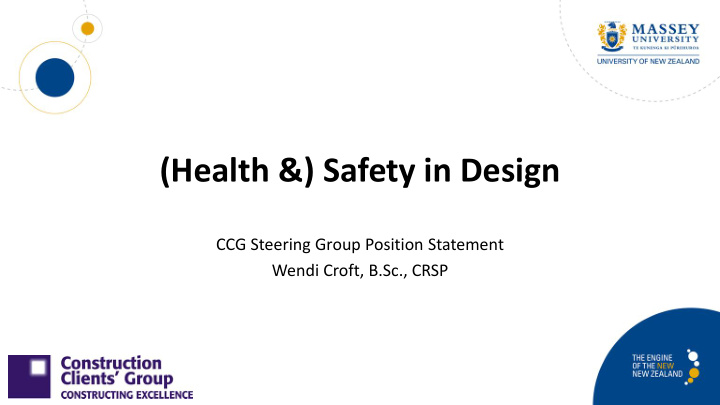



(Health &) Safety in Design CCG Steering Group Position Statement Wendi Croft, B.Sc., CRSP
The purpose of this group is to establish a consistent understanding of safety in design under the new legislative regime and create a forum for sharing, challenging and empowering its members to apply these principles.
SID – Why worry? What % of incidents can be attributed to design? 70% 60% 50% 40% 30% 20% 10% 0% UK 1980s Australia Australia Australia UK 2004 2011 2002 1992 Design played a role
What design elements are causing fatalities? % of Design Related Fatalities Inadequate guarding Lack of roll-over protection / seat belts Lack of residual current device (RCD)
Case Study – Abbeystead, UK May 1984, 16 died after a methane gas explosion destroyed a waterworks' valve house Source of the methane gas as coal seams 1,200 m below the pipeline 55% liability - Designers for failing to exercise "reasonable care" in assessing the risk of methane 30% liability – Water Authority for failing to ensure the plant was safe for visitors and employees by testing for methane 15% liability – Contractor for failing to carry out systematic tests for methane
Casey Study – Luton Airport, UK 2009 Elderly woman died on a pedestrian crossing at Luton Airport 75% Liability – owner, Luton Airport 25% Liability – design subcontractor Total fines NZD $1million.
New Zealand Casey Study – Hamilton Zoo, NZ September 2015 Zoo keeper killed by a Sumatran tiger when she entered the cage thinking that the tiger was locked in its night enclosure. Hamilton City Council found guilty for failing to take all practical steps.
How does the law work? Legislative Frameworks – Due Diligence Act Duty to do everything SFAIRP Few specific controls (e.g., conduct Regulations tests and provide information) Codes of Practice Practical guidance Guidelines Standards / Directives
The Construction (Design and Management) Machinery Directive 42/EC 2006 Regulations 1994 ANSI/ ASSE Z590.3 Standard 2011 Health and Safety at Work Act 2015 Health and Safety at Work Regulations ISO 12100 Safety of Machinery – General Principles for Design 2010 2016 Occupational Health and Safety Act 2004 Occupational Health and Safety Regulations 2007 Code of Practice for the Safe Design of Structures 2012
Comparison of Key Elements Australia USA Europe International UK Safe Design of ANSI/ ASSE Machinery Key Element Structures ISO 12100 Z590.3 Directive CDM Regulations Knowledge & Capability X X Consultation, Collaboration X X Consider the Full Lifecycle X X X X Risk Management Approach X X X X X Information Transfer X X X X X Level Code of Practice Standard Standard Directive Regulation Application All Machinery All Machinery Construction
Our Position – the Australian CoP It is our position that the key elements of safety in design as outlined in the CoP be implemented by PCBUs in New Zealand to achieve their duty of care.
BUT… it requires context… Consider in context for the size and complexity of the product or project. The core principles should be made relevant to other industries or aspects of design including: – manufacturing or heavy industry – retrofits, upgrades or refurbishments – plant, equipment, control systems or substances.
Scope New Zealand organisations should specifically include health (and environmental) factors into their safety in design frameworks.
Scope Special consideration should be made to apply health and safety in design principles to the software and control systems associated with any plant, substance or structure.
Risk Management Approach Each PCBU should identify the risk tool which is appropriate to their operations and designs. Controls should be implemented based on the risk regardless of the industry in which they are being applied.
Risk Management Approach Tests, calculations and analysis should be applied as required by the relevant technical standards and over-arching quality process. Testing should form a critical part of a pre- commissioning phase especially where there are multiple designs, PCBUs or discreet bodies of work which come together to provide one functional unit.
Consider the Lifecycle PCBUs should consider all potential uses and misuses of the plant, substance, structure or control system being designed, especially where the potential consequences are high.
Knowledge & Capability Where a PCBU identifies itself as a “designer”, it should establish resources, roles and responsibilities to manage this duty of care. A foundation for all competencies should include awareness of the key elements of health and safety in design as they are relevant to the individual’s duty of care .
Knowledge & Capability PCBUs should assess the core competencies for each designer individually. This should be based on core technical competencies associated with the professional advise or technical contribution to the design. Peer reviews should be included as an independent check that the relevant professional standards have been met, especially where there are high risks.
Consultation, cooperation and co-ordination Where there is a shared duty by multiple PCBUs, the responsibility for should be assigned to a specific individual to lead, coordinate and monitor. PCBUs should ensure consultation is completed early with those affected.
WorksafeNZ Icebreaker 6
Information Transfer Manuals, reports, registers or other expected method of information transfer should be identified at the beginning of any contract or engagement.
Cost effective prevention Cost to control health or design risk
Thank You
Recommend
More recommend